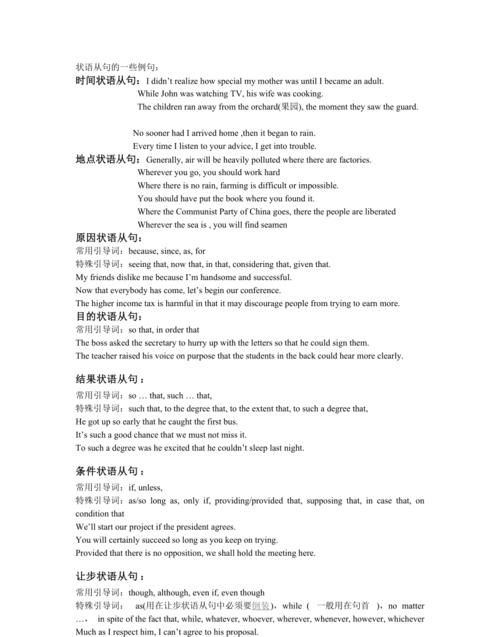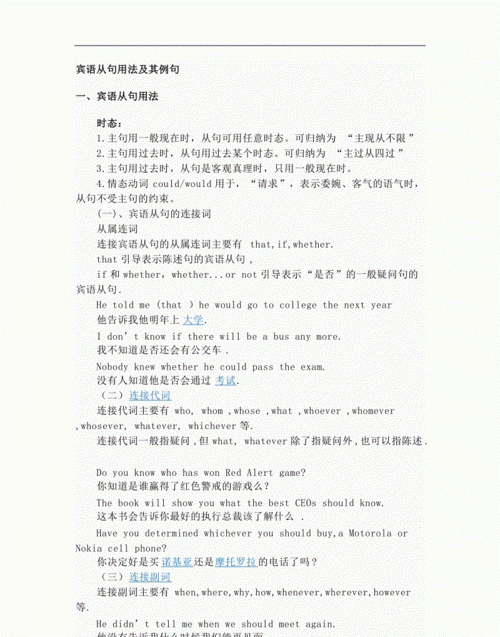本文目录
英语从句经典例句讲解长句
主语从句
1)主语从句可直接位于主语的位置,如果从句较长,谓语又较短,可用it作形式主语,而将从句放在句末。常见的句型有:
It is said that comic books create a connection between people of the same generation
It seems that the performance is very useful.
2)what引导的主语从句表示“...的东西时”,一般不用it作形式主语。
What we lack is experience.
3)what,who,when,why,whether等词含有各自的疑问意义,但它们引导的主语从句,都用陈述语序。
How the plan is to be carried out should be discussed again.
2.宾语从句
1)宾语从句可位于及物动词、介词和某些形容词后。连词that常可省略。介词后一般接疑问词引导的宾语从句。in that(因为),except that(除了),but that(只是)已构成固定搭配,其他介词后一般不接that引导的宾语从句。
I promised that I would change the situation.
3.表语从句
表语从句出现在结构为“主语+系动词+表语从句”的句子中。表语从句除可用that,what,when,why,whether,how等引导外,还可由because,as if(though)等引导。that常可省略。如主句主语为reason,只能用that引导表语从句,不可用because.
Perhaps the most important thing to remember is that there is no one common type of life in America. 请点击输入图片描述
请点击输入图片描述请点击输入图片描述
4.同位语从句
同位语从句用于对前面出现的名词作进一步说明,一般用连词that引导,由于先行名词的意义不同,也可用whether,who,when,where,what,why,how等引导。常见的先行名词fact,idea,belief,news,hope,conclusion,evidence,suggestion,order,problem,report,decision.有时由于谓语较短,将同位语从句位于谓语之后。
She finally made the decision that she would join the fashion show.
I had no idea how many books I could borrow at a time.
The news came that their team had won the championship.

5.定语从句
定语从句所修饰的先行词可以是名词或代词,也可以是一个句子。定语从句通常位于先行词之后,由关系代词或关系副词引导。
This is the computer on which he spent all his savings
It is written by a person with whom we are all familiar.
6.状语从句
*时间状语从句
As soon as I sent an e-mail message,I received positive responses.
The moment he heard the good news,he jumped with joy.
*地点状语从句
Considering that he is a freshman,we must say he is doing well.
Mickey Mouse is so attractive that the children are reluctant to leave.
We got up early this morning so that we could catch the first bus to the railway station.
*条件和让步状语从句
As long as you have the right equipment,you can use a telephone line to transmit computer data.
No matter what you may say,I would not change my mind.
Young as he is,he is quite experienced in this work.(=though he is young)
Child as he is,he can speak English fluently.(=though he is a child)
*方式状语从句
The young man made the experiment just as the teacher had taught him.
Everything went on as usual as if nothing had happened.
英语从句类型总结图
从句,是复句中具有分属地位的分句,它是一种绝大部分语言都有的语法结构。在现代汉语的语法中,“从句”不作为专业术语被使用。下面是我整理的英语从句类型总结,欢迎阅读!
一. 宾语从句object clause:
定义definition:
在句子中起宾语作用的从句叫做宾语从句。
连接词connections:
that: I think that you can pass the exam.
Whether/if: I don’t know what the word means. “Wh”: I don’t know what the word means.
I don’t know where he found the book.
只用whether的情况: 1. 与or not连用:
I don’t know whether it’s raining or not. 2. 与动词不定式连用:
He doesn’t know whether to accept the invitation. 3. 连接词前有介词时:
It depends on whether he is coming. 三. 时态tenses:
1. 主句是一般现在时态,从句根据实际情况而定(各种时态均可) She wants to know what he has done for the exam.
2.主句是一般过去时态,从句用相应的过去的时态。 1)She said that she was a student.
2)She said that she would fly to Japan in a week.
3)She said that she had finished her homework already.
3. 如果宾语从句说的是客观真理、自然现象或事实时,这时宾语从句要用一般现在时态。
The teacher said that the earth goes round the sun.
二. 定语从句 Attributive clause:
1. 定义:在复合句中修饰名词、代词的从句叫定语从句 2. 先行词指人 who /that 先行词指物 which/ that
3. 定语从句一般紧跟被修饰的名词或代词(即先行词)后
4.关系代词代替先行词在句子中担当成分,所以从句中不可再出现其他代替先行词的'代词
5.翻译方法 “…. 的” Eg.
1. Yesterday we bought a book which is really hard to understand.
2. The students who are from Maple Leaf School like learning English.
Whom: 先行词指人,则代替先行词在定语从句中充当宾语(包括介词的宾语), 与who的区别是如果前面带介词则必须用whom 1. This is the teacher whomwho we like best. 2. I don’t like the boy to whom you are talking. Whose : 指人或物,作定语,表示 “…的”
eg: Harry is the boy whose mother is our math teacher.
关系代词只能 that 的特殊情况:
1.先行词前有序数词修饰时:
This is the first gift that my parents bought me. 2.先行词前有形容词最高级修饰时:
This is the most exciting film that I have ever seen. 3. 先行词是不定代词something, anything等时.
e.g. Is there anything that you want in this shop 4. 先行词是人和物时, 用that.
e.g. He talked about some writers and books that were unknown to us all.
5. 先行词被all , little , the only , the very(就是,正是), the last 等词修饰时,只能用that
e.g. This is the last place that I want to visit.
6. 特殊疑问句以who 或which 开头,只能用that引导. Who is the girl that is making a speech on the platform? 当关系代词前使用介词时:
物+介词+which 人+ 介词 + whom 当关系代词前使用介词时:
e.g. 1. This is the train by which we went to Beijing.
2. This is the teacher to whom my mother is talking.
三. 状语从句:Adverbial clauses
定义:
在复合句中由从句表示的状语称作状语从句,它可以用来修饰谓语(包括非谓语动词)、定语或状语,或是整个句子。 状语从句一般分为八大类
时间状语从句 地点状语从句 原因状语从句 目的状语从句 结果状语从句 条件状语从句 方式状语从句 让步状语从句
1. 时间状语从句
When ---当……时候, 通常指某一特定的时间点,主句与从句的动作同时发生。
When I opened the window, I saw him come up. When --- 正在……的时候,突然…。通常主句是进行时或 be about to 时,在翻译的时候,when 可以译成没想到或突然。 I was walking along the street , when I met him.
When 当从句是进行时,主句是一般时,往往表示不满。 Someone knocked at the door when I was having breakfast. When=after
When the children had gone to bed, she began to prepare her lessons. While ---在……期间,往往指一段时间。 While we were in America, we saw him twice.
While ---表示一种不满情绪,意思是这边在干某种重要的事,而另一边在享受等。
We are cleaning the classroom while they are playing the football. As --- 一边……一边, 随着
She was doing her homework as she was listening to the music.
As --- 当……时,指一个动作紧接着一个动作发生,从句通常用进行时。 As I was going out, it began to rain.
The moment --- 一……就…… =as soon as , immediately, ---Did you remember to give Mary the money you owed her? ---Yes, I gave her the moment I saw her. Not… until --- 直到……才
He didn’t leave the office until he finished the work. Before --- 在……之前
The passengers should arrive at the airport an hour before the flight departs. After --- 在…… 之后
The customer left the ticket counter after he had a quarrel with the ticket agent. Since ---自从……, 通常主句用现在完成时
I have never been there again since I graduated from the university.
It is just a week since we arrived here. As soon as --- 一……就……
Jack went to school as soon as he got well. No sooner than --- 一……就……
no sooner… than… 用于句首要求倒装 Hardly …when… Scarcely …when…
No sooner had he arrived than he went away again. Once --- 一但……就……
Once you see him, you will never forget him. Every time, each time 每次whenever 每当
Each time he came to town, he would visit our school.
2. 条件状语从句
引导状语从句的连接词有:
If如果, unless除非, as long as只要, As (so) far as --- 据……所知,in case万一, provided that假如, on condition that若是,以…为条件 If ---如果
If you don’t hurry up, you will miss the plane. Unless --- 如果不, 除非=if not
We can’t get there on time unless we book the earliest flight As long as --- 只要
We will succeed as long as we keep on trying. As (so) far as --- 据……所知
As far as I know, he speaks English very well. In case --- 假使, 如果
The plane cannot take off in case it rains.

详细举例讲一讲各种英语从句的用法
一.主语从句
主语从句是在复合句中充当主语的从句,通常放在主句谓语动词之前或由形式主语it代替,而本身放在句子末尾.
1. It 作形式主语和it引导强调句的比较
It 作形式主语代替主语从句,主要是为了平衡句子结构,主语从句的连接词没有变化.而it引导的强调句则是对句子某一部分进行强调,无论强调的是什么成分,都可用连词that.被强调部分指人是也可用who/whom.例如:
It is a pity that you didn’t go to see the film.
It doesn’t interest me whether you succeed or not.
It is in the morning that the murder took place.
It is John that broke the window.
2. 用it 作形式主语的结构
(1) It is +名词+从句
It is a fact that … 事实是…
It is an honor that …非常荣幸
It is common knowledge that …是常识
(2) it is +形容词+从句
It is natural that… 很自然…
It is strange that… 奇怪的是…
(3) it is +不及物动词+从句
It seems that… 似乎…
It happened that… 碰巧…
(4) it +过去分词+从句
It is reported that… 据报道…
It has been proved that… 已证实…
3. 主语从句不可位于句首的五种情况
(1) if 引导的主语从句不可居于复合句句首.
(2) It is said , (reported) …结构中的主语从句不可提前.例如:
It is said that President Jingo will visit our school next week. (right)
That President Jiang will visit our school next week is said. (wrong)
(3) It happens…, It occurs… 结构中的主语从句不可提前.例如:
It occurred to him that he failed in the examination. (right)
That he failed in the examination occurred to him. (wrong)
(4) It doesn’t matter how/whether …结构中的主语从句不可提前.例如:
It doesn’t matter whether he is wrong or not. (right)
Whether he is wrong or not doesn’t matter. (wrong)
(5) 含主语从句的复合句是疑问句时,主语从句不可提前.例如:
Is it likely that it will rain in the evening? (right)
Is that will rain in the evening likely? (wrong)
4. What 与that 在引导主语从句时的区别
What 引导主语从句时在句时在从句中充当句子成分,如主语.宾语.表语,而that 则不然.例如:
1) What you said yesterday is right.
2) That she is still alive is a consolation.
二.宾语从句
宾语从句就是在复合句中作宾语的名词性从句,通常放在主句谓语动词(及物动词)或介词之后.
1. 作动词的宾语
(1) 由that引导的宾语从句(that 通常可以省略),例如:
I heard that be joined the army.
(2) 由what, whether (if) 引导的宾语从句,例如:
1) She did not know what had happened.
2) I wonder whether you can change this note for me.
(3) 动词+间接宾语+宾语从句.例如:
She told me that she would accept my invitation.
2. 作介词的宾语
例如:Our success depends upon how well we can cooperate with one another.
3. 作形容词的宾语
例如:I am afraid (that) I’ve made a mistake.
That 引导的从句常跟在下列形容词后作宾语:
Anxious, aware, certain, confident, convinced, determined, glad, proud, surprised, worried, sorry, thankful, ashamed, disappointed, annoyed, pleased, hurt, satisfied, content 等.也可以将此类词后的that 从句的看作原因状语从句.
4. It 可以作为形式宾语
It 不仅可以作为形式主语,还可以作为形式宾语而真正的宾语that 从句则放在句尾,特别是在带复合宾语的句子中. 例如:
We heard it that she would get married next month..
5. 后边不能直接跟that 从句的动词
这类动词有Allow, refuse, let, like, cause, force, admire, condemn, celebrate, dislike, love, help, take, forgive等.这类词后可以用不定式或动名词作宾语,但不可以用that引导的宾语从句.例如:
I admire their winning the match. (right)
I admire that they won the match. (wrong)
6. 不可用that从句作直接宾语的动词
有些动词不可用于“动词+间接宾语+that从句“结构中,常见的有Envy, order, accuse, refuse, impress, forgive, blame, denounce, advise, congratulate等.例如:
He impressed the manager as an honest man. (right)
He impressed the manager that he was an honest man. (wrong)
7. 否定的转移
若主句谓语动词为Think, consider, wuppose, believe, expect, fancy, guess, imagine等,其后的宾语从句若含有否定意义,一般要把否定词转移到主句谓语上,从句谓语用肯定式.例如:
I don’t think this dress fits you well.(我认为这件衣服不适合你穿.)
三.表语从句
表语从句在复合句中作表语的名词性从句,放在系动词之后,一般结构是“主语+连系动词+表语从句”.可以接表语从句的连系动词有be, look, remain, seem等.引导表语从句的that常可省略.另外,常用的还有the reason is that… 和It is because 等结构.例如:
1) The question is whether we can make good preparation in such a short time.
2) This is why we can’t get the support of the people
3) But the fact remains that we are behind the other classes.
4) The reason he is late for school is that he missed the early bus.
四.同位语从句
同位语从句就是在复合句中作名词的同位语的名词性从句.
1. 同位语从句的功能
同位语从句对于名词进一步解释,说明名词的具体内容,一般由that引导,例如:
1) The king’s decision that the prisoner would be set free surprised all the people.
2) The order that all the soldiers should stay still is given by the general.
2. 同位语在句子中的位置
同位语从句有时可以不紧跟在它所说明的名词后面,而是被别的词隔开.例如:
He got the news from Mary that the sports meeting was put off.
3. 同位语从句与定语从句的区别
(1) 定语从句中的that既代替先行词,同时以在从句中作某个成分(主语或宾语),而同位语从句中的that是连词,只起连接主句与从句的作用,不充当句中任何成分.
(2) 定语从句是形容词性的,其功能是修饰先行词,对先行词加以限定,描述定的性质或特征;同位语从句是名词性的,其功能是对名词进行补充说明.例如:
1) The news that he told me is that Tom would go abroad next year.(他告诉我的消息是汤姆明年将出国.)(第一个that引导的从句是定语从句,that在从句中作宾语)
2)The news that Tom would go abroad is told by him.(汤姆将出国的消息是他讲的.)(同位语从句,that在句中不作任何成分)

英语写作各种高级从句句型总结
1.名词从句
① It would mean a great deal to me to listen to the tape and learn what is covered in the talk. ( 2004 全国卷 Ⅲ )
② My hometown is no longer what it used to be.
2.(非限制性)定语从句
① The flat is in a building on Fangcao Street. It is not far from Jianxin Chinese School.→
The flat is in a building on Fangcao Street, which is not far from Jianxin Chinese School. (NMET 2003)
② It was quite an experience for us both, which I’ll never forget for the rest of my life. (2002 北京卷)
【复合句】:定语从句、名词性从句、状语从句。
一、定语从句:
1. that,which,who的使用。一个句子当中有两个相同的名词,将其中的一个名词进行替换,如果是人,用who;如果是物,用which;that既可以指人又可以指物。
2. 谓语动词(结构)和后面的介词有两种关系:关系紧密&关系疏远;定语从句中如果谓语结构和介词关系紧密,则介词必须保留在谓语结构的后面,不能做任何位置的改动;如果谓语结构和介词关系疏远,介词一般提到which/who/that的前面; 介词加which正好表示时间,可以表达成whe- n;表示地点时,可以表达成where;表示原因时,变成why;
3. 限定性定语从句和非限定性定语从句。限定性定语从句:定语从句和关系词关系非常紧密,删掉定语从句后,整个句子意思会改变;非限定性定语从句:定语从句和关系词关系不是很紧密,删掉定语从句后,整个句子意思不会改变,定语从句只起到补充说明的意义;
eg: He won the first place in the competition, which is out of our expectation.
② 非限定性定语从句:which引导非限制性定语从句只能放在后面,as则只能放在句子前面
二、名词性从句:主语从句、宾语从句、表语从句及同谓语从句;
形式:名词+从句;
连接词取决于后面的从句是什么样的形式;
如果是陈述句,直接加that引导;
一般疑问句:先把一般疑问句变成陈述句语序,然后在其前加上weather或者if;
特殊疑问句:直接保留特殊疑问词,后面的句子变成陈述句语序;
定义:在句子中起名词作用的句子,且在句子中能担任主语、宾语、表语、同谓语、介词宾语等成分;
eg. Yuminhong, the president of New Oriental School.
三、状语从句:
两个独立的句子中间用一些含义不同的连接词连接;状语从句用来表达两个句子之间的逻辑关系;分成原因状语、条件状语、结果状语、时间状语、地点状语、让步状语、目的状语、比较状语、方式状语等九大类型;
定语从句是名词+关系词+从句,关系词的用法取决于名词的问题;
名词性从句:同谓语从句:名词+关系词+从句,关系词跟后面的从句有关系,如果是陈述句,直接加that引导;
一般疑问句:先把一般疑问句变成陈述句语序,然后在其前加上weather或者if;
特殊疑问句:直接保留特殊疑问词,后面的句子变成陈述句语序;
宾语从句:动词+关系词+从句;
表语从句:系动词+关系词+从句;
主语从句:关系词+从句+谓语动词;
名词性从句,其关系词的来源取决于后面的从句的性质。
状语从句:完整句子1+逻辑关系词+完整句子2;
如何区分定语从句和同谓语从句:whether,what,how接在名词后面一定是同谓语从句;关系词是when ,where,why如果前面不是时间、地点、人物,那么是同谓语从句;如果是的话,则为定语从句;如果见到which的话,which在句中翻译成“哪一个”,就是同谓语;翻译不成“哪一个”就是定语从句;that 就是看它在句中是否充当成分,如果充当成分就是定语从句;不充当成分就是同谓语从句;
Whether the plan is feasible remains to be proved. (主语从句)
是否这个计划是可行的仍然值得去考证。
I worry about whether he can pass through the crisis of his illness. (宾语从句)
我担心他是否能度过疾病的危险期。
They are investigating the question whether the man is trustworthy. (同谓语从句)
At time when hiring qualified people is becoming more difficult(定语从句),employers who can eliminate invalid bias from the process have a distinct advantage. (定语从句)
在雇佣合格人才变得越来越困难的时期,那些能够在雇佣过程中消除站不住脚的偏见的雇主具有明显的'优势。
Eg. While (让步状语从句)even the modestly educated sought an elevated tone when (时间状语从句)they put pen to paper before the 1960s, even the most well regarded writing since then has sought to capture spoken English on the page.
在20世纪60年代之前,当人们伏案写作的时候,即使那些接受教育不多的人也会追求一种高雅的风格,但是从那以后,即使是那些令人敬仰的文学作品也在追求一种口语的风格。
Eg. About 45% of the world's population lived in the climate zone where mosquito transmit disease . 全球45%的人口都生活在这样的一个区域,这个地方的蚊子会传播疾病。
Eg.He was an Asian American (who was) raised in a household where respectful zones in authority was show by averting your eyes . (定语从句) 他是一个亚裔美国人,在他生长的环境当中,避免与有权威的人对视是对对方尊重的一种表现。

以上就是关于英语各种从句例句 ,英语从句经典例句讲解长句的全部内容,以及英语各种从句例句 的相关内容,希望能够帮到您。

